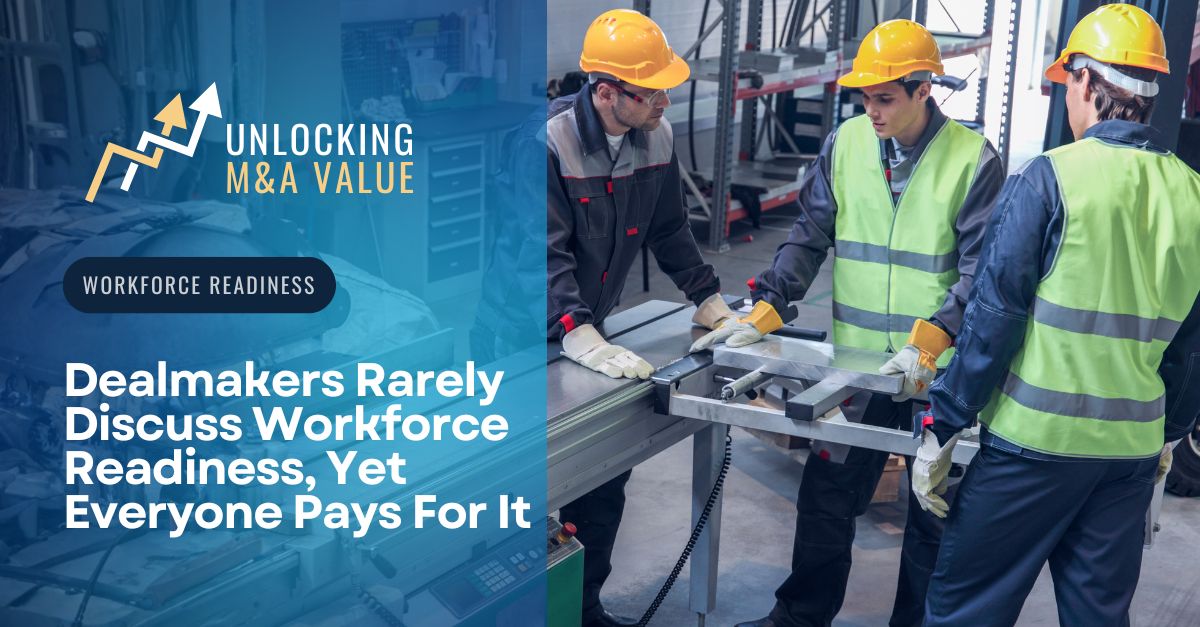
Most M&A teams will tell you they evaluate workforce readiness during diligence. Then, you review the materials, and the topic is covered in two slides and a retention chart.
That is the first warning sign. Everyone loves running financial models and synergy scenarios, but very few take a hard look at whether the people inside the business are actually capable of running the operation after the deal closes.
The workforce makes or breaks the deal. Not the investment thesis, not the cost-takeout plan, and not the integration schedule. Those things only work if the people in the organization are ready to operate as a unified system. If they are not, everything slows down, clogs up, or falls apart under pressure. We have watched deals succeed and fail on this exact point. It is predictable and avoidable, but only if workforce readiness is no longer treated as an HR talking point and instead becomes a matter of operational due diligence.
The Workforce Is a Deal Asset, Not a Line Item
Buyers expend considerable effort calculating synergy value, but few ask the most critical question: Can the workforce actually deliver the results being modeled? You do not answer that question by reading job descriptions. You answer it by understanding how frontline leaders run the day, how supervisors communicate and solve problems, whether middle management coordinates or reacts, whether executives set clear expectations and follow through, whether KPIs are realistic or optimistic, and whether daily routines exist or “heroics” are carrying the operation.
When these elements are solid, integration moves quickly. When they are weak, every promise in the model becomes a struggle.
The Hard Cost of an Unready Workforce
Once the deal closes, the numbers no longer matter. Execution does. An unready workforce immediately impacts productivity, manifesting as slower throughput, longer changeovers, unstable schedules, inconsistent shift execution, rising downtime, quality drift, higher overtime, increased turnover, and widening performance gaps between shifts or sites. These are not post-transaction adjustment periods. They are structural issues that were already present and simply exposed by change.
External research confirms what operators already know. Most acquisitions fail to meet their synergy targets due to issues tied to people and culture. Harvard Business Review identified cultural and behavioral misalignment as the leading cause of deal underperformance. Deloitte repeatedly reports that leadership capability gaps derail integration more often than any technical failure. None of this is surprising if you have walked a plant floor during a merger. The places where operations fall apart are the same places where the workforce was not ready before the ink dried.
Operators Live the Reality Deal Teams Overlook
Deal teams assume clean transitions. Operators absorb the actual disruption. Financial forecasts assume rapid adoption of new expectations, clear communication, disciplined execution, consistent accountability, and alignment across levels and locations. Operators often live something very different when the workforce is unprepared. They face confusion, mixed messages, unclear responsibilities, and pressure to fix problems that leadership underestimated. Integration slows, variation increases, and the synergy plan starts slipping quarter after quarter.
When daily execution is unstable, integration cannot stabilize. When leadership does not model discipline, teams revert to old habits. When middle managers cannot communicate effectively or coach, silos tighten.
The Three Layers That Determine Whether the Deal Works
To determine whether a combined organization will perform effectively, you examine three key levels.
1Executive readiness determines whether clarity, direction, and timely decisions exist.
Executives who hesitate, avoid conflict, or rely on corporate phrasing instead of plain language generate confusion and slow the organization down.
2Middle management readiness is the biggest risk point and the most ignored.
Middle managers are the link between strategy and execution. When they cannot communicate expectations, coordinate across functions, or reinforce standards, integration drifts and deal value evaporates quickly.
3Frontline readiness is where the operation either stabilizes or breaks.
If frontline leaders do not run disciplined startups, escalate issues, own changeovers, or follow standard work, the plant will never stabilize. Throughput drops, downtime increases, and maintenance backlogs grow, while every improvement takes twice as long and delivers only half the value. Frontline readiness is not a cultural question. It is a productivity question.
Successful Integrations Have One Common Trait
The operations that integrate well are the ones that already run as a disciplined system. They have clear expectations, reliable routines, leaders who confront problems early, KPIs that reflect reality, problem-solving that occurs daily rather than monthly, a Management Operating System that aligns the entire site, and real-time visibility through tools like DPS, ensuring that nothing gets hidden. These are the conditions that enable faster, smoother, and more predictable integration. Deals are won or lost in daily execution. If the operating system cannot support the combined business, the deal value never materializes.
Why Workforce Readiness Matters More Now
Manufacturing M&A activity is climbing. Reshoring, consolidation, private equity roll-ups, and capacity expansions are driving transactions across all sectors. Deals are happening quickly, but operational stability is not keeping pace. Organizations that treat workforce readiness as a checklist item will feel the consequences through missed targets, stalled integration, and unexpected turnover.
Integration does not fail because the model was wrong. It fails because the workforce was unprepared for the reality behind the model.
How POWERS Helps Organizations Build a Workforce Ready for M&A Integration
At POWERS, our management consulting approach helps manufacturers move beyond short-term fixes to build sustainable performance systems. We design and implement Management Operating Systems that embed bottleneck detection, problem-solving discipline, and frontline leadership capability into daily operations. Our consultants work alongside your teams on every shift and in every process to make improvement a repeatable part of how your business runs.
- Speak to an Expert: Call +1 678-971-4711 to discuss how frontline leadership development and DPS can close your skills gap and streamline tech adoption.
- Email Us: Reach out to info@thepowerscompany.com for personalized insights on reducing friction in your operations.
- Request an Assessment: Visit our online contact form to schedule an assessment with our expert consultants, identifying quick wins to equip your leaders and boost performance.

